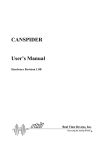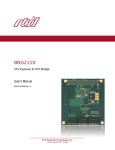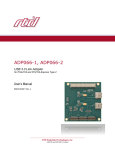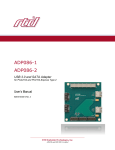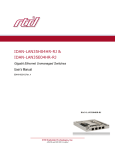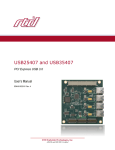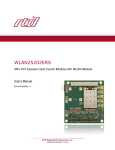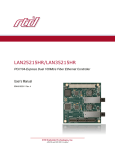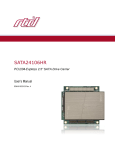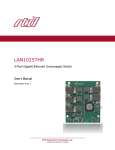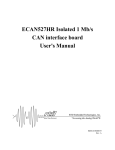Download CAN SPIDER - RTD Embedded Technologies, Inc.
Transcript
CAN SPIDER CAN Bus Hub User’s Manual BDM-610040004 Rev. C RTD Embedded Technologies, Inc. AS9100 and ISO 9001 Certified RTD Embedded Technologies, Inc. 103 Innovation Boulevard State College, PA 16803 USA Telephone: 814-234-8087 Fax: 814-234-5218 www.rtd.com [email protected] [email protected] Revision History Rev A Rev B Rev C Initial Release Corrected twisted pair CAN port connector table, added new board photo Changed format and added changes to match features on Rev D PCB Advanced Analog I/O, Advanced Digital I/O, aAIO, aDIO, a2DIO, Autonomous SmartCal, “Catch the Express”, cpuModule, dspFramework, dspModule, expressMate, ExpressPlatform, HiDANplus, “MIL Value for COTS prices”, multiPort, PlatformBus, and PC/104EZ are trademarks, and “Accessing the Analog World”, dataModule, IDAN, HiDAN, RTD, and the RTD logo are registered trademarks of RTD Embedded Technologies, Inc (formerly Real Time Devices, Inc.). PS/2 is a trademark of International Business Machines Inc. PCI, PCI Express, and PCIe are trademarks of PCI-SIG. PC/104, PC/104-Plus, PCI-104, PCIe/104, PCI/104-Express and 104 are trademarks of the PC/104 Embedded Consortium. All other trademarks appearing in this document are the property of their respective owners. Failure to follow the instructions found in this manual may result in damage to the product described in this manual, or other components of the system. The procedure set forth in this manual shall only be performed by persons qualified to service electronic equipment. Contents and specifications within this manual are given without warranty, and are subject to change without notice. RTD Embedded Technologies, Inc. shall not be liable for errors or omissions in this manual, or for any loss, damage, or injury in connection with the use of this manual. Copyright © 2013 by RTD Embedded Technologies, Inc. All rights reserved. RTD Embedded Technologies, Inc. | www.rtd.com iii BRG2110 User’s Manual Table of Contents 1 2 3 4 Introduction 6 1.1 Product Overview........................................................................................................................................................................ 6 1.2 Board Features ........................................................................................................................................................................... 6 1.3 Ordering Information ................................................................................................................................................................... 6 1.4 Contact Information .................................................................................................................................................................... 6 1.4.1 Sales Support 6 1.4.2 Technical Support 6 Specifications 7 2.1 Operating Conditions .................................................................................................................................................................. 7 2.2 Electrical Characteristics ............................................................................................................................................................ 7 Board Connection 8 3.1 Board Handling Precautions ....................................................................................................................................................... 8 3.2 Physical Characteristics .............................................................................................................................................................. 8 3.3 Connectors and Jumpers ............................................................................................................................................................ 9 3.3.1 External I/O Connectors 9 3.3.2 Bus Connectors 9 3.3.3 Jumpers 9 X9: CAN Bus Termination 9 X10: CAN Bus Termination 10 JP1: J5 CAN +5V 10 JP2: J4 CAN +5V 10 3.4 Steps for Installing .................................................................................................................................................................... 11 Functional Description 12 4.1 Block Diagram........................................................................................................................................................................... 12 4.2 CAN Bus ................................................................................................................................................................................... 12 4.3 Power ........................................................................................................................................................................................ 14 4.3.1 +8 to + 36 Input Volt Power Supply 14 4.3.2 +5 Volt Isolated Supply 14 5 Troubleshooting 15 6 Additional Information 16 6.1 7 PC/104 Specifications ............................................................................................................................................................... 16 Limited Warranty RTD Embedded Technologies, Inc. | www.rtd.com 17 iv BRG2110 User’s Manual Table of Figures Figure 1: Board Dimensions ..................................................................................................................................................................................... 8 Figure 2: Board Connections .................................................................................................................................................................................... 9 Figure 3: Example 104™Stack ............................................................................................................................................................................... 11 Figure 4: CAN SPIDER Block Diagram .................................................................................................................................................................. 12 Figure 5 CANSpider Application Example .............................................................................................................................................................. 13 Figure 6 CANSpider Standalone Application Example........................................................................................................................................... 14 Table of Tables Table 1: Ordering Options ........................................................................................................................................................................................ 6 Table 2: Operating Conditions .................................................................................................................................................................................. 7 Table 3: Electrical Characteristics ............................................................................................................................................................................ 7 Table 4: X9 Settings ................................................................................................................................................................................................. 9 Table 5: X10 Settings ............................................................................................................................................................................................. 10 Table 6: JP1 Settings .............................................................................................................................................................................................. 10 Table 7: JP2 Settings .............................................................................................................................................................................................. 10 RTD Embedded Technologies, Inc. | www.rtd.com v BRG2110 User’s Manual 1 Introduction 1.1 Product Overview This manual gives information on the CAN Spider active CAN bus hub. The CAN Spider can connect up to four fiber optic ECAN527-2 PC/104 CAN bus interface boards together. Other CAN bus devices may be connected to the galvanically isolated twisted pair CAN port. This structure enables flexible expansion of CAN Spiders as well as connection of twisted pair CAN devices to your network. 1.2 Board Features 1.3 Fiber optic CAN Ports with data rates up to 1 Mbps Two galvanically isolated twisted pair CAN ports for system expansion Onboard bus termination resistors with jumpers Onboard power supply with 8 – 36VDC input range Power outputs +5VDC and isolated +5VDC Ordering Information The CAN SPIDER is available with the following options: Table 1: Ordering Options Part Number CAN SPIDER 1.4 Description Fiber-optic CAN Bus Hub Module Contact Information 1.4.1 SALES SUPPORT For sales inquiries, you can contact RTD Embedded Technologies sales via the following methods: Phone: E-Mail: 1.4.2 1-814-234-8087 [email protected] Monday through Friday, 8:00am to 5:00pm (EST). TECHNICAL SUPPORT If you are having problems with you system, please try the steps in the Troubleshooting section of this manual. For help with this product, or any other product made by RTD, you can contact RTD Embedded Technologies technical support via the following methods: Phone: E-Mail: 1-814-234-8087 Monday through Friday, 8:00am to 5:00pm (EST). [email protected] RTD Embedded Technologies, Inc. | www.rtd.com 6 BRG2110 User’s Manual 2 Specifications 2.1 Operating Conditions Table 2: Operating Conditions 2.2 Symbol VIN Ta Ts RH Parameter Supply Voltage J1 Operating Temperature Storage Temperature Relative Humidity MTBF Mean Time Before Failure Test Condition Min Max 8 -40 -55 0 Non-Condensing Telcordia Issue 2 30°C, Ground benign, controlled 36 +85 +125 90% Unit V C C % 10,844 Hours Max 0.75 5.25 9 5.25 Unit W V A V 66 mA +36 3.0 V V MBd Electrical Characteristics Table 3: Electrical Characteristics Symbol P VOUT5 IOUT5 VOUT5ISO IOUT5ISO VCAN Vdiff 1/tbit Parameter Test Condition Power Consumption VIN = 8 - 30V +5V Output Supply Voltage +5V Output Supply Current +5V Isolated Supply Voltage +5V Isolated Supply Current J2, J4 & J5 combined CAN Bus Twisted Pair CANH, CANL input/output voltage Differential bus voltage Maximum transmission speed Non-return-to-zero CAN Bus Fiber HFBR-1522 Transmitter HFBR-2522 Reciever Data Rate Cable Length Min 4.75 4.75 -36 1.5 1 1 45 MBd M Note: The fiber optic transceivers are classified as IEC 825-1 Accessible Emission Limit (AEL) Class 1 based upon the current proposed draft scheduled to go to effect on January 1, 1997. AEL Class 1 LED devices are considered eye safe. RTD Embedded Technologies, Inc. | www.rtd.com 7 BRG2110 User’s Manual 3 Board Connection 3.1 Board Handling Precautions To prevent damage due to Electrostatic Discharge (ESD), keep your board in its antistatic bag until you are ready to install it into your system. When removing it from the bag, hold the board at the edges, and do not touch the components or connectors. Handle the board in an antistatic environment, and use a grounded workbench for testing and handling of your hardware. 3.2 Physical Characteristics Weight: Approximately 100 g (0.22 lbs.) Dimensions: 90.17 mm L x 95.89 mm W (3.550 in L x 3.775 in W) Figure 1: Board Dimensions RTD Embedded Technologies, Inc. | www.rtd.com 8 BRG2110 User’s Manual 3.3 Connectors and Jumpers X10 Termination Jumper J4 Twisted Pair CAN Bus Fiber RXD 1 8 – 36V Input GND GND +5V Output Fiber TXD 1 Fiber RXD 2 Fiber TXD 2 Fiber RXD 3 Isolated Gnd Isolated +5V Fiber TXD 3 J5 Twisted Pair CAN Bus Fiber RXD 4 Fiber TXD 4 X9 Termination Jumper Figure 2: Board Connections 3.3.1 EXTERNAL I/O CONNECTORS 3.3.2 J1 – VIN +8 – 30 VDC Input J2 – VOUT5ISO +5 VDC Isolated Output J3 – VOUT5 +5 VDC Output J4 and J5 – CAN Bus Twisted Pair Interfaces RXD1 to RXD4 – Fiber receiver inputs TXD1 to TXD4 – Fiber Transmitter outputs BUS CONNECTORS The CAN Spider is physically PC/104 size with the same mounting holes, but it does not have a bus connector. 3.3.3 JUMPERS On all jumpers, pin 1 is designated by a thick white silkscreen line, and a square pad on the PCB. X9: CAN Bus Termination X9 is used to terminate the CAN bus twisted pair near J5. Table 4: X9 Settings Setting 1-2 Shorted 1-2 Open Description CAN bus terminated at J5 end (Default) CAN bus not terminated at J5 end RTD Embedded Technologies, Inc. | www.rtd.com 9 BRG2110 User’s Manual X10: CAN Bus Termination X10 is used to terminate the CAN bus twisted pair near J4. Table 5: X10 Settings Setting 1-2 Shorted 1-2 Open Description CAN bus terminated at J4 end (Default) CAN bus not terminated at J4 end JP1: J5 CAN +5V JP1 is used to provide isolated +5V to CAN bus connector J5 pin 8. Table 6: JP1 Settings Setting 1-2 Shorted 1-2 Open Description Isolated +5V on CAN bus connector J5 pin 8 (Default) J5 pin 8 open JP2: J4 CAN +5V JP2 is used to provide isolated +5V to CAN bus connector J4 pin 8. Table 7: JP2 Settings Setting 1-2 Shorted 1-2 Open Description Isolated +5V on CAN bus connector J4 pin 8 (Default) J4 pin 8 open RTD Embedded Technologies, Inc. | www.rtd.com 10 BRG2110 User’s Manual 3.4 Steps for Installing 1. 2. 3. 4. 5. 6. 7. 8. 9. 10. 11. 12. Always work at an ESD protected workstation, and wear a grounded wrist-strap. Turn off power to the PC/104 system or stack. Select and install stand-offs to properly position the module on the stack. Remove the module from its anti-static bag. Check that pins of the bus connector are properly positioned. Check the stacking order; make sure all of the busses used by the peripheral cards are connected to the cpuModule. Hold the module by its edges and orient it so the bus connector pins line up with the matching connector on the stack. Gently and evenly press the module onto the PC/104 stack. If any boards are to be stacked above this module, install them. Attach any necessary cables to the PC/104 stack. Re-connect the power cord and apply power to the stack. Boot the system and verify that all of the hardware is working properly. Figure 3: Example 104™Stack RTD Embedded Technologies, Inc. | www.rtd.com 11 BRG2110 User’s Manual 4 Functional Description 4.1 Block Diagram The Figure below shows the functional block diagram of the CAN SPIDER. The various parts of the block diagram are discussed in the following sections. Figure 4: CAN SPIDER Block Diagram 4.2 CAN Bus The CANSpider active CAN bus hub can connect up to four fiber optic CAN devices, such as RTD’s ECAN527-2 PC/104 CAN bus interface boards together. Additional CAN bus devices may be connected to the galvanically isolated twisted pair CAN ports. This structure enables flexible expansion of CAN Spiders as well as connection of twisted pair CAN devices to your network. The flow through from J4 to J5 with jumperable termination resisters allows simple cascading of CANSpiders for more fiber ports or to attach additional twisted pair ports. See Figure 5 CANSpider Application Example and Figure 6 CANSpider Standalone Application Example. RTD Embedded Technologies, Inc. | www.rtd.com 12 BRG2110 User’s Manual Figure 5 CANSpider Application Example RTD Embedded Technologies, Inc. | www.rtd.com 13 BRG2110 User’s Manual Figure 6 CANSpider Standalone Application Example 4.3 Power The main power input to the CAN Spider is 8 – 36 volts. The board makes +5V and isolated +5V as described below. 4.3.1 +8 TO + 36 INPUT VOLT POWER SUPPLY The main power input is 8 – 36 volts on J1. This input is converted to 25 watts of +5 volts. This power is used to power the isolated +5 volt supply and is available on J1 for external devices. See Table 3: Electrical Characteristics for details. 4.3.2 +5 VOLT ISOLATED SUPPLY The +5V is also used to make an isolated +5V that powers the fiber interfaces and can optionally be used to power the devices on the twisted pair cable at J4 and/or J5. See Table 6: JP1 Settings and Table 7: JP2 Settings for more information and Table 3: Electrical Characteristics for specifications. RTD Embedded Technologies, Inc. | www.rtd.com 14 BRG2110 User’s Manual 5 Troubleshooting If you are having problems with your system, please try the following initial steps: Simplify the System – Remove modules one at a time from your system to see if there is a specific module that is causing a problem. Perform you troubleshooting with the least number of modules in the system possible. Swap Components – Try replacing parts in the system one at a time with similar parts to determine if a part is faulty or if a type of part is configured incorrectly. If problems persist, or you have questions about configuring this product, contact RTD Embedded Technologies via the following methods: Phone: E-Mail: +1-814-234-8087 [email protected] Be sure to check the RTD web site (http://www.rtd.com) frequently for product updates, including newer versions of the board manual and application software. RTD Embedded Technologies, Inc. | www.rtd.com 15 BRG2110 User’s Manual 6 Additional Information 6.1 PC/104 Specifications A copy of the latest PC/104 specifications can be found on the webpage for the PC/104 Embedded Consortium: www.pc104.org RTD Embedded Technologies, Inc. | www.rtd.com 16 BRG2110 User’s Manual 7 Limited Warranty RTD Embedded Technologies, Inc. warrants the hardware and software products it manufactures and produces to be free from defects in materials and workmanship for one year following the date of shipment from RTD Embedded Technologies, Inc. This warranty is limited to the original purchaser of product and is not transferable. During the one year warranty period, RTD Embedded Technologies will repair or replace, at its option, any defective products or parts at no additional charge, provided that the product is returned, shipping prepaid, to RTD Embedded Technologies. All replaced parts and products become the property of RTD Embedded Technologies. Before returning any product for repair, customers are required to contact the factory for a Return Material Authorization (RMA) number. This limited warranty does not extend to any products which have been damaged as a result of accident, misuse, abuse (such as: use of incorrect input voltages, improper or insufficient ventilation, failure to follow the operating instructions that are provided by RTD Embedded Technologies, “acts of God” or other contingencies beyond the control of RTD Embedded Technologies), or as a result of service or modification by anyone other than RTD Embedded Technologies. Except as expressly set forth above, no other warranties are expressed or implied, including, but not limited to, any implied warranties of merchantability and fitness for a particular purpose, and RTD Embedded Technologies expressly disclaims all warranties not stated herein. All implied warranties, including implied warranties for merchantability and fitness for a particular purpose, are limited to the duration of this warranty. In the event the product is not free from defects as warranted above, the purchaser's sole remedy shall be repair or replacement as provided above. Under no circumstances will RTD Embedded Technologies be liable to the purchaser or any user for any damages, including any incidental or consequential damages, expenses, lost profits, lost savings, or other damages arising out of the use or inability to use the product. Some states do not allow the exclusion or limitation of incidental or consequential damages for consumer products, and some states do not allow limitations on how long an implied warranty lasts, so the above limitations or exclusions may not apply to you. This warranty gives you specific legal rights, and you may also have other rights which vary from state to state. RTD Embedded Technologies, Inc. | www.rtd.com 17 BRG2110 User’s Manual RTD Embedded Technologies, Inc. 103 Innovation Boulevard State College, PA 16803 USA Telephone: 814-234-8087 Fax: 814-234-5218 www.rtd.com [email protected] [email protected] Copyright 2013 by RTD Embedded Technologies, Inc. All rights reserved.


















